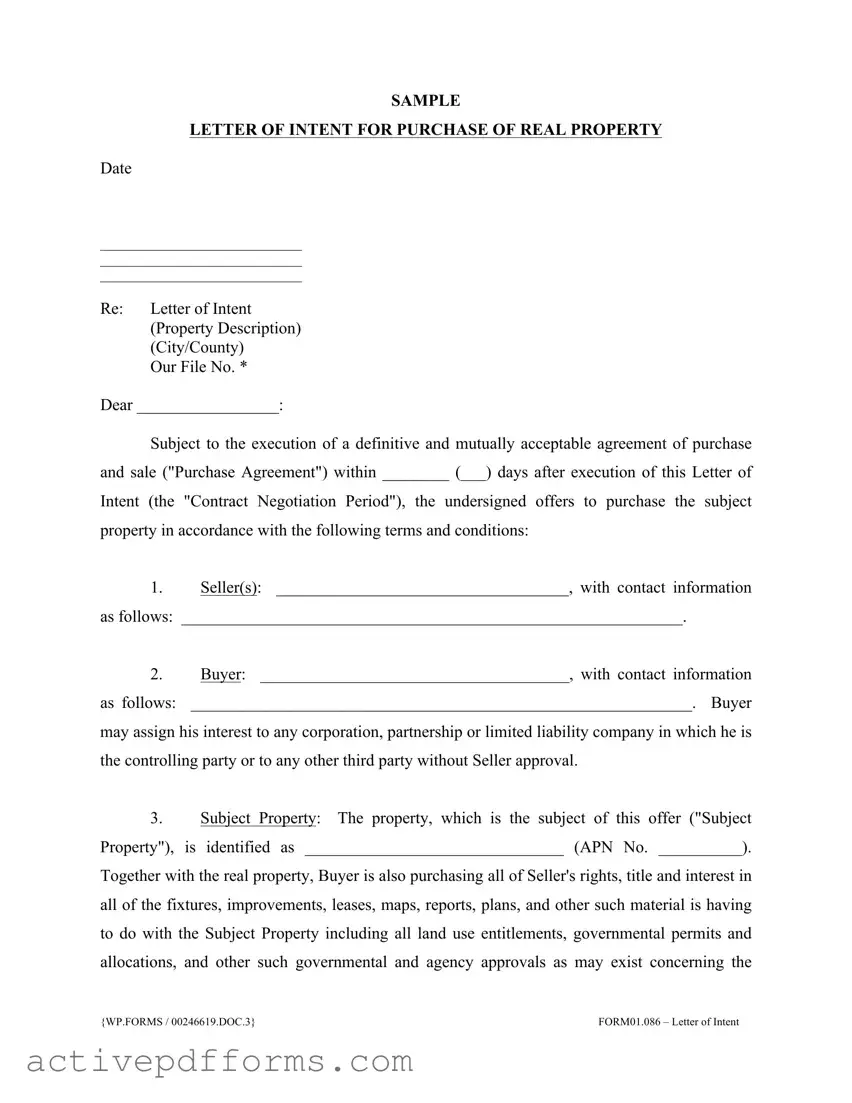SAMPLE
LETTER OF INTENT FOR PURCHASE OF REAL PROPERTY
Date
_____________________________
_____________________________
_____________________________
Re: Letter of Intent (Property Description) (City/County)
Our File No. *
Dear _________________:
Subject to the execution of a definitive and mutually acceptable agreement of purchase and sale ("Purchase Agreement") within ________ (___) days after execution of this Letter of
Intent (the "Contract Negotiation Period"), the undersigned offers to purchase the subject property in accordance with the following terms and conditions:
1.Seller(s): ___________________________________, with contact information
as follows: ____________________________________________________________.
2.Buyer: _____________________________________, with contact information
as follows: ____________________________________________________________. Buyer may assign his interest to any corporation, partnership or limited liability company in which he is the controlling party or to any other third party without Seller approval.
3.Subject Property: The property, which is the subject of this offer ("Subject Property"), is identified as _______________________________ (APN No. __________). Together with the real property, Buyer is also purchasing all of Seller's rights, title and interest in all of the fixtures, improvements, leases, maps, reports, plans, and other such material is having to do with the Subject Property including all land use entitlements, governmental permits and allocations, and other such governmental and agency approvals as may exist concerning the
{WP.FORMS / 00246619.DOC.3} |
FORM01.086 – Letter of Intent |
_____________________
_____________________
Page 2
property. In addition, this offer to purchase includes the following specific items: ___________
____________________________________________.
4.Purchase Price: ___________________ ($________).
5.Terms of Purchase: ________________________________________________
___________________________________________________.
6.Opening of Escrow: Escrow ("the Purchase Escrow") shall be opened at
______________ Title Company within three (3) business days from execution of this Letter of Intent. The Purchase Agreement and Mutual Escrow Instructions shall be mutually prepared and executed by Buyer and Seller within ________ (___) days of execution by both parties of this Letter of Intent to purchase (the "Contract Negotiation Period").
7.Deposit Toward Purchase Price:
A.Initial Deposit: Concurrently with the opening of escrow, Buyer shall place therein the sum of ___________________________ Dollars ($____________) as a refundable deposit toward and applicable to the Purchase Price ("the Initial Deposit"). Escrow Holder shall deposit such sum in an interest-bearing, federally insured account with interest accruing for the benefit of Buyer.
B.Second Deposit: An additional non-refundable deposit of
__________________________ Dollars ($____________) shall be applicable to the Purchase Price and upon approval of the feasibility shall be released to Seller, inclusive of the Initial Deposit.
8.Feasibility Period: Buyer shall have until ________________ to perform all feasibility and due diligence for subject property. Seller shall fully cooperate with Buyer in
_____________________
_____________________
Page 3
providing any and all information available regarding the development potential of the property. Buyer may terminate this Letter of Intent and/or the Purchase Agreement at any time prior to the end of the Feasibility Period for any reason or no reason at all upon written notification to Seller and Escrow Holder of the termination. Upon notice of termination, Escrow Holder shall be instructed to immediately release the Initial Deposit made by Buyer and return to Buyer within five (5) business days of termination.
9.Buyer's Condition Precedent to Closing: Following the expiration of the Feasibility Period, Buyer's obligation to close escrow shall be subject only to the following conditions:
A.Title Company shall be in position to issue a policy of title insurance to Buyer in the full amount of the Purchase Price showing good and marketable title vested in Buyer subject only to such exceptions to title as have been approved by Buyer during the Feasibility Period.
B.The non-existence of any development, building, construction, flood or moratoria affecting the Subject Property.
C.Seller to provide Buyer title to property free and clear of liens except for non-delinquent bonds and taxes.
10.Close of Escrow: Close of escrow to be on _______________________.
_____________________
_____________________
Page 4
11.Other Provisions:
A.The Purchase Agreement may contain other provisions such as, but not limited to, a liquidated damages clause, attorney's fees, notices, mutual indemnifications, broker's commission, and the like.
B.Any and all documentation provided by Seller to Buyer shall be returned to Seller upon cancellation of this transaction.
12.Expiration of Offer: This Letter of Intent shall constitute an open offer until
____________, at which time it shall be automatically terminated if not executed by Seller.
If the above outline of terms and conditions are acceptable, please indicate by signing below. All parties to these transactions intend that this proposal be superseded by a the Purchase Agreement. In the meantime, all parties agree to proceed in accordance with terms and conditions outlined in this Letter of Intent. Seller understands the purpose of this Letter of Intent is to allow further investigation by both parties into the feasibility of entering into a formal agreement. This Letter of Intent is only binding on the parties during the Contract Negotiation period. If the Purchase Agreement is not mutually executed within the Contract Negotiation Period for any reason whatsoever or no reason at all, this Letter of Intent shall expire and no party shall have any further rights or duties hereunder. Seller shall not solicit other offers during the Contract Negotiation Period.
BUYER:
________________________________ |
Dated: _________________ |
SELLER:
________________________________ |
Dated: _________________ |
_____________________
_____________________
Page 5
